Jean-Louis Prévost, a name that resonates with the delicate beauty and scientific precision of botanical art, stands as a significant figure in the golden age of French flower painting. Flourishing in the late eighteenth and early nineteenth centuries, Prévost captured the ephemeral splendor of flowers and fruits with a masterful touch, leaving behind a legacy of exquisite watercolors, oil paintings, and influential published collections. His work skillfully navigated the realms of decorative art and scientific illustration, earning him a distinguished place among the celebrated botanical artists of his era. This exploration delves into the life, artistic style, major works, and enduring influence of Jean-Louis Prévost, an artist whose creations continue to enchant and inform.
Early Life and Artistic Genesis
Born around 1760, likely in Nointel, France, Jean-Louis Prévost, often referred to as Prévost le Jeune (the Younger) to distinguish him from other artists of the same name, including potentially an elder brother or relative, emerged during a period of immense cultural and scientific fervor in France. The Enlightenment had fostered a profound interest in the natural world, and botany, in particular, was a field of burgeoning study and popular fascination. This environment provided fertile ground for artists specializing in the depiction of flora.
Prévost's formal artistic training, according to some accounts, included an apprenticeship under Jean-Baptiste Bouchard, a painter of flowers and birds. This tutelage would have immersed him in the established traditions of still life and decorative painting. Furthermore, his association with the renowned Sèvres porcelain manufactory (Manufacture de Sèvres) was crucial. At Sèvres, artists were trained to an exceptionally high standard of precision and decorative sensibility, as their designs were intended for transfer onto delicate porcelain. This experience undoubtedly honed Prévost's meticulous technique and his eye for elegant composition. He reportedly studied alongside his two brothers, Jean-Jacques Prévost and Guillaume Prévost, suggesting a familial engagement with the arts.
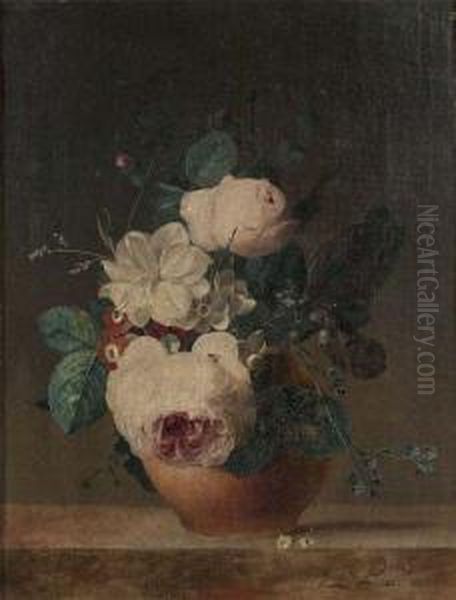
The artistic milieu of Paris at this time was vibrant. The Royal Academy of Painting and Sculpture (Académie Royale de Peinture et de Sculpture) set the standards, but numerous other avenues for artistic development and exhibition existed. Flower painting, long a respected genre, was experiencing a particular renaissance, influenced by earlier Dutch masters like Jan van Huysum and Rachel Ruysch, but now infused with a distinct French elegance and often a more scientific underpinning. Artists like Gerard van Spaendonck, who became Professor of Flower Painting at the Jardin du Roi (later Jardin des Plantes), and Anne Vallayer-Coster were prominent contemporaries, elevating the status of still life and floral art. Prévost was thus entering a field rich in tradition yet open to new interpretations.
A Distinctive Artistic Style: Bridging Huysum and Redouté
Jean-Louis Prévost's artistic style is often characterized as a harmonious blend, occupying a unique space between the opulent, almost extravagant floral arrangements of the Dutch Golden Age painter Jan van Huysum and the more overtly scientific, though still aesthetically refined, botanical illustrations of his contemporary Pierre-Joseph Redouté. Prévost's works exhibit a remarkable technical virtuosity, a keen sensitivity to the nuances of color and texture, and an unerring sense of composition.
His flower paintings are celebrated for their accuracy in depicting individual species. Each petal, leaf, and stem is rendered with careful attention to botanical detail, yet this precision does not result in sterile, purely diagrammatic representations. Instead, Prévost imbued his subjects with life and vibrancy. He masterfully captured the delicate translucency of rose petals, the velvety texture of pansies, and the intricate structures of lilies and tulips. His palette was rich and varied, employing subtle gradations of tone to convey form and depth.
Unlike the often dense and overflowing bouquets of Van Huysum, Prévost's compositions, while generous, tend to possess a certain lightness and grace that is characteristically French. His arrangements feel naturalistic, as if freshly gathered, yet they are artfully constructed to create balanced and visually pleasing designs. He often placed his bouquets in simple vases or baskets, or depicted them as loose sprays, sometimes incorporating fruits, insects, or dewdrops to enhance the realism and add points of interest, a common trope seen in the work of artists like Jan Davidsz. de Heem centuries earlier.
Compared to Redouté, who famously worked for Empress Joséphine and whose primary aim was often botanical documentation for works like Les Liliacées or Les Roses, Prévost's output, while botanically sound, often leaned more towards the decorative. His paintings and prints were intended not only for study but also for aesthetic enjoyment, suitable for adorning the elegant interiors of the time. This dual appeal—scientific integrity coupled with artistic charm—was a hallmark of his success. His ability to render flowers with both accuracy and an undeniable artistic flair set him apart.
Masterworks and Enduring Contributions
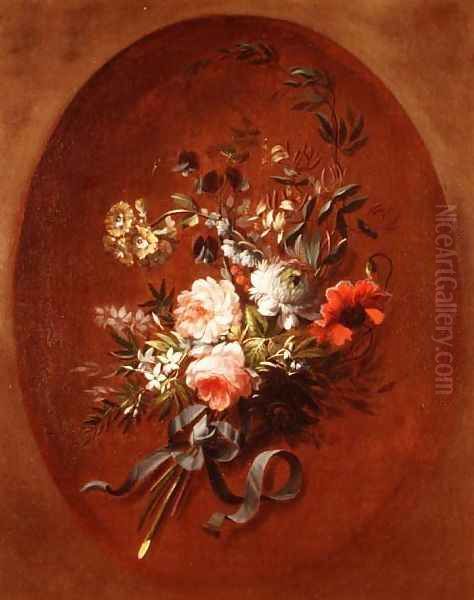
Jean-Louis Prévost's most significant and enduring contribution to botanical art is undoubtedly his magnificent publication, Collection des Fleurs et des Fruits, peints d'après nature (Collection of Flowers and Fruits, Painted from Nature). Published in Paris around 1805, this work comprises a series of stunningly beautiful stipple engravings, exquisitely colored by hand (à la poupée and finished by hand with watercolor), based on Prévost's original watercolor paintings. The Collection is widely regarded as one of the finest French floral books of the early nineteenth century.
Each plate in the Collection des Fleurs et des Fruits is a testament to Prévost's skill. The arrangements are diverse, featuring popular garden flowers like roses, tulips, lilies, carnations, peonies, and hyacinths, alongside various fruits such as grapes, peaches, and plums. The compositions are elegant, the colors vibrant and true to life, and the engraving technique captures the subtle textures and delicate forms of the subjects. This work served not only as a beautiful art book but also as a valuable resource for gardeners, botanists, and designers. It provided models for students of flower painting and inspiration for decorative artists working in textiles, wallpaper, and porcelain. The success of such publications relied on skilled engravers like Charles Louis Lingée or Jean Baptiste Chapuy who could translate the painter's vision into printable form.
Beyond this seminal publication, Prévost produced numerous individual watercolors and oil paintings of floral still lifes. Titles such as Bouquet of Roses, Roses, Forget-me-nots, Violets, and Roses, Anemones, Pansies (these may refer to specific plates from his Collection or similar series) indicate his fondness for these particular blooms. His works were sought after by collectors and were influential in shaping contemporary tastes in floral decoration.
His skills were also employed in collaborative projects. Notably, he worked with the Rouches-Jeanroux brothers, associated with the Vincennes porcelain manufactory (a precursor to Sèvres, or a contemporary entity), illustrating a work titled Horti Cellensis. This project, which reportedly involved the creation of over 1800 illustrations over two years, underscores his prodigious output and his ability to work to the exacting standards required for transfer to porcelain, a field where artists like Jacques Barraband also excelled in bird painting for Sèvres.
The Parisian Art Scene: Exhibitions and Recognition
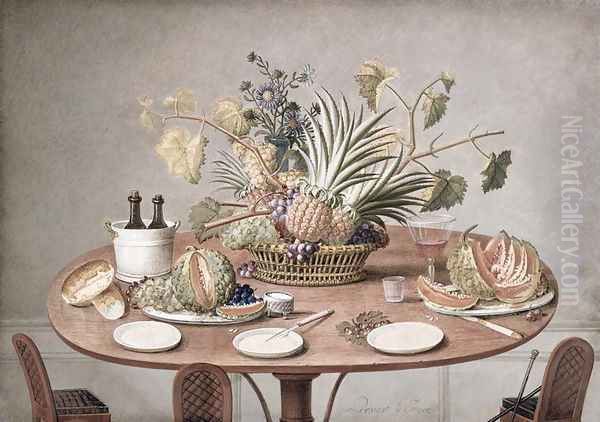
Jean-Louis Prévost was an active participant in the Parisian art world. He exhibited his works at several important venues, which provided artists with opportunities for exposure, patronage, and critical assessment. The official Paris Salon, organized by the Académie Royale (and later under different state bodies after the Revolution), was the most prestigious of these. Prévost is recorded as having exhibited at the Salon, for instance, in 1802. Participation in the Salon was a mark of professional standing and could significantly enhance an artist's reputation.
Prior to the Revolution, and during periods when the official Salon was restrictive, alternative exhibition venues also played a role. Prévost is noted to have exhibited at the Salon de la Correspondance, an independent salon established by Pahin de la Blancherie in the 1770s and 1780s, which offered a platform for a wider range of artists, including those not yet members of the Academy. Some sources also mention an early exhibition at the Salon de St. Luc in 1774. If Prévost was born around 1760, this would mean he exhibited at the remarkably young age of fourteen, suggesting either prodigious talent or that this entry might pertain to an older artist of the same name. However, given his later accomplishments, early promise is certainly plausible.
The critical reception of Prévost's work would have been shaped by the prevailing aesthetic theories of the time, which valued verisimilitude (truth to nature), skillful execution, and pleasing composition. Flower painting, while sometimes considered lower in the hierarchy of genres than historical or mythological subjects (as championed by artists like Jacques-Louis David), was nonetheless highly appreciated for its beauty and technical demands. Prévost's ability to satisfy both the scientific eye with his accuracy and the aesthetic sensibility with his artistry ensured his favorable reception.
Contemporaries and the Broader Artistic Milieu
Prévost worked within a rich ecosystem of artists, botanists, patrons, and craftsmen. His contemporaries in the specialized field of flower painting in Paris included some of the most celebrated names in the genre. Pierre-Joseph Redouté (1759-1840) is perhaps the best-known, famed for his work for Empress Joséphine at Malmaison and his exquisite stipple engravings of roses and lilies. While Redouté's work often had a more pronounced scientific focus, both artists shared a commitment to botanical accuracy and aesthetic beauty.
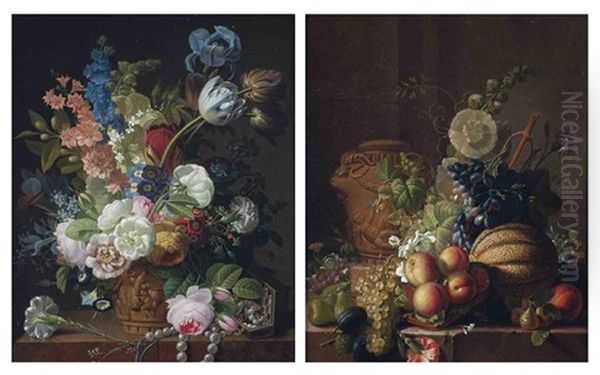
Gerard van Spaendonck (1746-1822), a Dutch artist who became a dominant figure in French flower painting, was another key contemporary. As Professor of Flower Painting at the Jardin des Plantes, he influenced a generation of artists, including Redouté himself. Van Spaendonck's style, characterized by rich colors, meticulous detail, and elegant compositions, set a high standard. Other notable flower painters active during Prévost's time included Jan Frans van Dael (1764-1840), a Flemish artist who also enjoyed considerable success in Paris, and Antoine Berjon (1754-1843) from the Lyon school, known for his vibrant and textured still lifes.
The Sèvres porcelain manufactory, where Prévost received training, was a hub of artistic talent. Artists there, whose names are often less individually famous but whose collective skill was immense, specialized in translating complex designs onto curved porcelain surfaces. This required not only artistic skill but also a deep understanding of how pigments would react during firing. The tradition of flower painting on porcelain was strong, with artists like Jean-Baptiste Monnoyer (1636-1699) having established a powerful French tradition in floral decoration much earlier, influencing tapestry, panel painting, and decorative arts for generations.
The interest in botany was not confined to artists. Scientists like Antoine Laurent de Jussieu were revolutionizing plant classification, and explorers were bringing back exotic new species from around the world. This scientific excitement fueled the demand for accurate botanical illustrations. Patrons, from royalty and aristocracy to the burgeoning bourgeois class, commissioned paintings, collected illustrated books, and cultivated elaborate gardens, creating a sustained market for artists like Prévost.
Legacy and Enduring Influence
Jean-Louis Prévost passed away around 1810, but his artistic legacy endured. His Collection des Fleurs et des Fruits remained a highly prized work, frequently consulted and admired for its beauty and accuracy. The individual plates were often separated and framed, becoming popular decorative items in their own right. The quality of his original watercolors and oil paintings ensured their preservation in private and public collections.
Prévost's influence extended to several areas. In botanical illustration, his work exemplified the successful marriage of scientific observation and artistic sensibility. He demonstrated that accuracy did not preclude beauty, and his compositions provided models for subsequent illustrators. In the decorative arts, his designs were adapted for use in textiles, wallpaper, and ceramics long after his death. The elegance and charm of his floral arrangements resonated with prevailing tastes for naturalistic yet refined ornamentation.
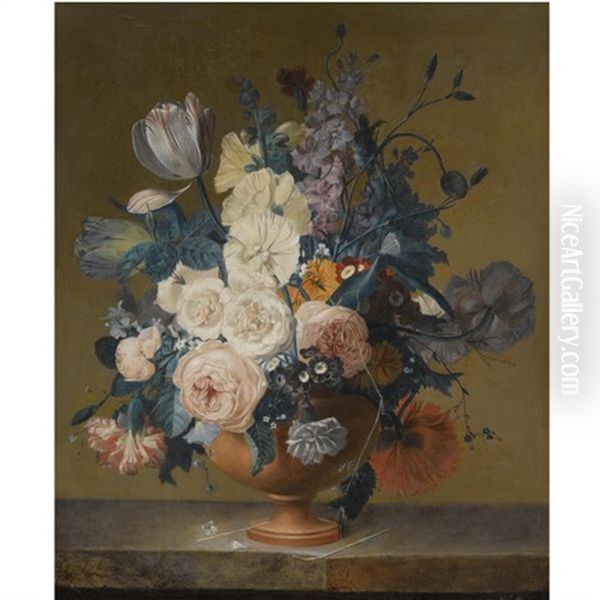
He is considered an important figure in what is often termed the "Golden Age" of French flower painting, a period spanning roughly from the mid-eighteenth to the mid-nineteenth century. This era saw an extraordinary flourishing of talent in this genre, driven by scientific curiosity, horticultural enthusiasm, and a sophisticated appreciation for art. Prévost, alongside Redouté, Van Spaendonck, and others, contributed significantly to this rich artistic tradition. His work represents a continuation of the great European still-life tradition, adapted to French tastes and informed by the scientific spirit of the Enlightenment.
Art historians and collectors today recognize Jean-Louis Prévost for his technical mastery, his delicate handling of color and light, and the sheer beauty of his floral depictions. His works are a window into the horticultural and artistic preoccupations of his time, capturing the transient beauty of flowers with an artistry that remains timeless.
Where to Find Prévost's Works Today
Works by Jean-Louis Prévost, particularly prints from his Collection des Fleurs et des Fruits, can be found in the collections of major museums, libraries, and botanical institutions around the world. These include institutions with strong holdings in prints and drawings or botanical art, such as the Fitzwilliam Museum in Cambridge, the Hunt Institute for Botanical Documentation in Pittsburgh, and the print rooms of national libraries and museums.
Original watercolors and oil paintings by Prévost appear less frequently on the art market but are highly valued when they do. Galleries specializing in European Old Master paintings and drawings, or those with a focus on botanical art, occasionally feature his work. For instance, Kerrisdale Gallery has been noted as a source for his original prints. Auction houses like Grosvenor Prints also handle such works. Publications like the American Engraving Society journal have documented his prints, indicating their recognized status among print collectors and connoisseurs.
The legacy of artists like Prévost is also preserved in the very objects his art inspired. Antique Sèvres or Vincennes porcelain pieces, if directly based on his designs, would be tangible links to his decorative work, though specific attributions can be complex. His influence, however, is more broadly seen in the stylistic trends of decorative arts from his period.
A Concluding Bloom
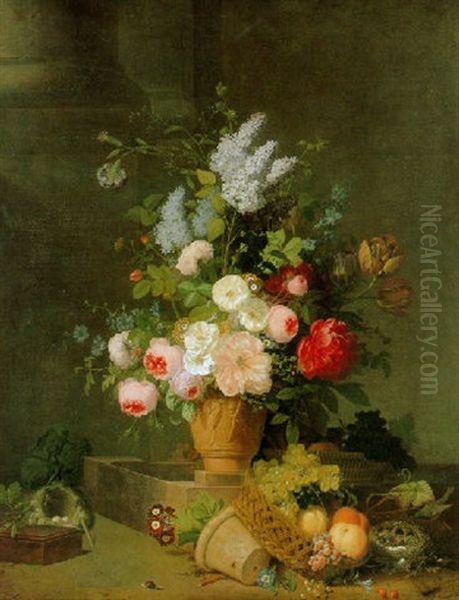
Jean-Louis Prévost le Jeune was more than just a painter of pretty flowers. He was a highly skilled artist and a keen observer of the natural world, operating at the intersection of art, science, and commerce. His meticulous technique, learned in the demanding environment of porcelain design and refined through dedicated practice, allowed him to capture the essence of each bloom with remarkable fidelity. Yet, his work was never merely illustrative; it was imbued with an elegance, a compositional harmony, and a sensitivity to color that elevated it to the realm of fine art.
In the grand tapestry of French art history, Prévost holds a specific and honored niche. He contributed to a genre that brought joy and beauty into people's lives, while also serving the burgeoning field of botanical science. His Collection des Fleurs et des Fruits stands as a monument to his talent and industry, a work that continues to delight the eye and inform the mind. Alongside contemporaries like Redouté and Van Spaendonck, and building on the legacy of earlier masters such as Monnoyer or even the Dutch pioneers like Ambrosius Bosschaert the Elder, Prévost helped to define the pinnacle of French floral painting, leaving behind a fragrant legacy that continues to bloom in collections and art historical appreciation worldwide. His art reminds us of the enduring appeal of nature's beauty and the remarkable human ability to capture its fleeting perfection.